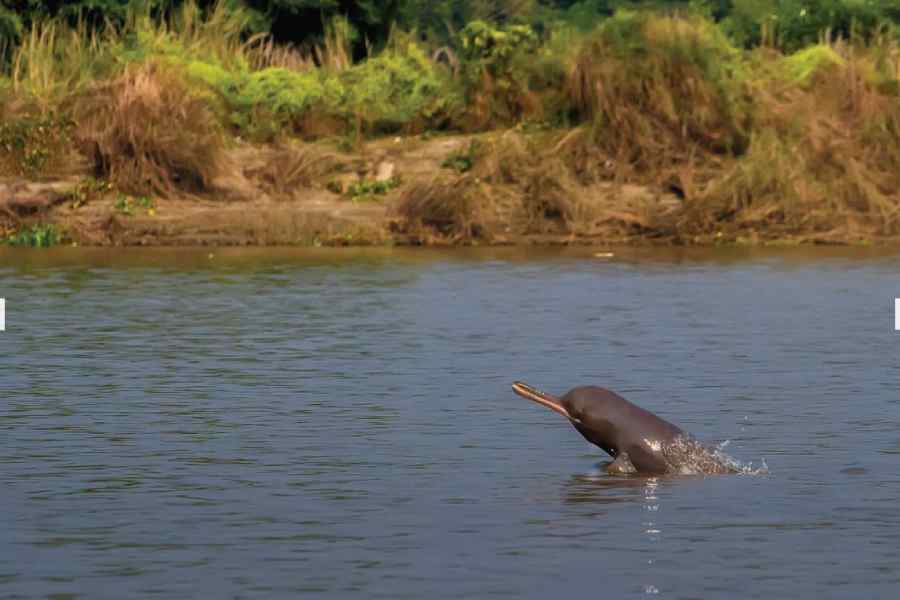A group of researchers will study the noise levels in the Hooghly to determine how habitable the river is for one of its most intelligent resident species.
The river is home to a stable population of the Gangetic dolphin (Platanista gangetica), an endangered species according to the International Union for Conservation of Nature.
Dolphins rely heavily on their sophisticated echolocation system, using sound waves to navigate, locate prey and communicate with one another. Human activities like shipping, underwater construction and offshore drilling introduce noise into the waters, which can have an adverse effect on these mammals.
“The study will look into the noise levels in the Hooghly — mainly the noise that comes from vessels of various sizes and other activities on the surface. Underwater sound recorders will be used to map the soundscape in the river. The aim is to be able to make a distinction between the different sources of sound,” said Anurag Danda, an environmentalist now serving as director, Sundarbans Programme, WWF-India, the NGO that will conduct the study.
“The objective of the study is to identify a sound threshold. Sound beyond that limit would interfere with the navigation system of the dolphins. If the ambient noise in the water overwhelms the sounds dolphins emit, it will be challenging for them to locate prey and communicate effectively,” said Danda.
The project details were discussed in a meeting on Friday, convened by the state transport department. The West Bengal Transport Infrastructure Development Corporation, which works under the transport department, is co-funding the project, along with the World Bank.
Representatives of WWF-India, officials of the state forest department and a scientist from the Central Pollution Control Board were among the participants.
After the completion of the study, a report will be submitted to the transport secretary and a copy will be shared with the chief wildlife warden of Bengal. The Gangetic dolphin is the national aquatic animal of India.
The estimated duration of the project will be 30 months and it will entail a cost of around ₹3 crore, said sources.
Inland waterways have been accorded a central role in maritime development in India. The National Waterways Act 2016 has declared 111 rivers or river stretches, creeks and estuaries as National Waterways that will see a significant rise in traffic and cargo volume.
The Ganga-Bhagirathi-Hooghly river system, spanning 1,620km and covering Uttar Pradesh, Bihar, Jharkhand and Bengal, is the longest.
The Hooghly waterway is set for major development, said a senior official in the state transport department. “The infrastructure upgrade includes construction of new jetties and remodelling of old ones. We are building smart gates and passenger terminals along the riverbank. We want to strike a balance between development and ecological balance. Dolphin is a treasure of the Hooghly. We will do everything in our capacity for the conservation of the species. The study is a step towards that direction,” said the official.
A 2021-2022 study done by the Wildlife Institute of India estimated 358 dolphins in the Hooghly between Farakka (Murshidabad) and Kakdwip (South 24-Parganas).
“The Ganga has been used as a waterway for a long time. The Hooghly already has a significant volume of traffic. As the volume goes up, it is important to find a threshold at which optimal benefit from the waterways can be achieved without affecting the ecology more than it is already being affected. That is why this study is important,” said Nachiket Kelkar, head, Riverine Ecosystems and Livelihoods programme, Wildlife Conservation Trust, and member, IUCN Cetacean Specialist Group.
A comprehensive study will broaden the scope of mitigation measures in the existing water transport system. “Then it will become ecologically less impactful. The findings might lead to corrective steps like changing the design of ship propellers or introducing speed limits and regulating traffic at certain times of the day or the year,” he said.
Gangetic dolphins already face a serious threat in Bengal from large-scale discharge of municipal waste, siltation and the countless brick kilns along the riverbanks.
Dolphins often get trapped in fishing nets when they rise to the surface to get enough air to breathe. But once trapped in nets, they cannot rise to breathe. Fishermen know instantly when a dolphin is trapped but there have been instances when they were killed to extract oil from the blubber, to be used as bait for fish.










